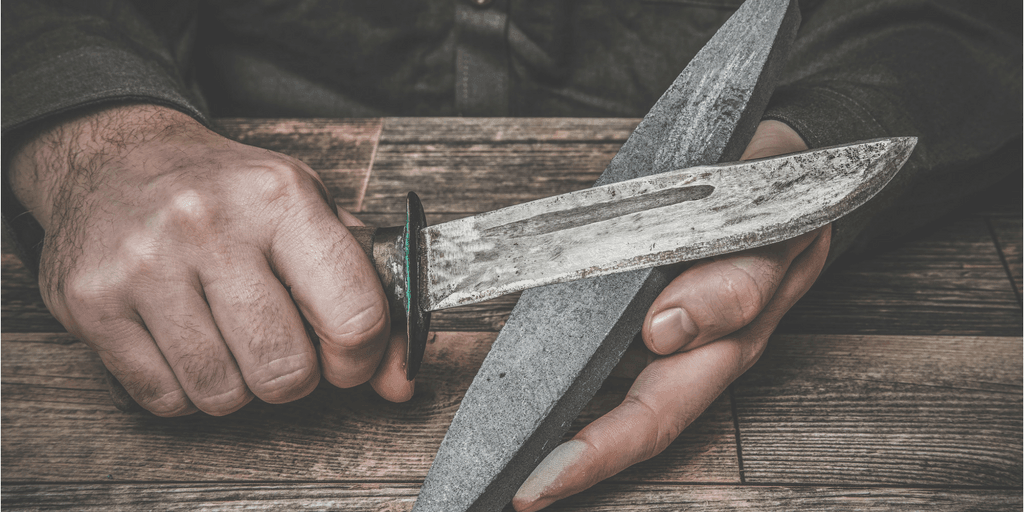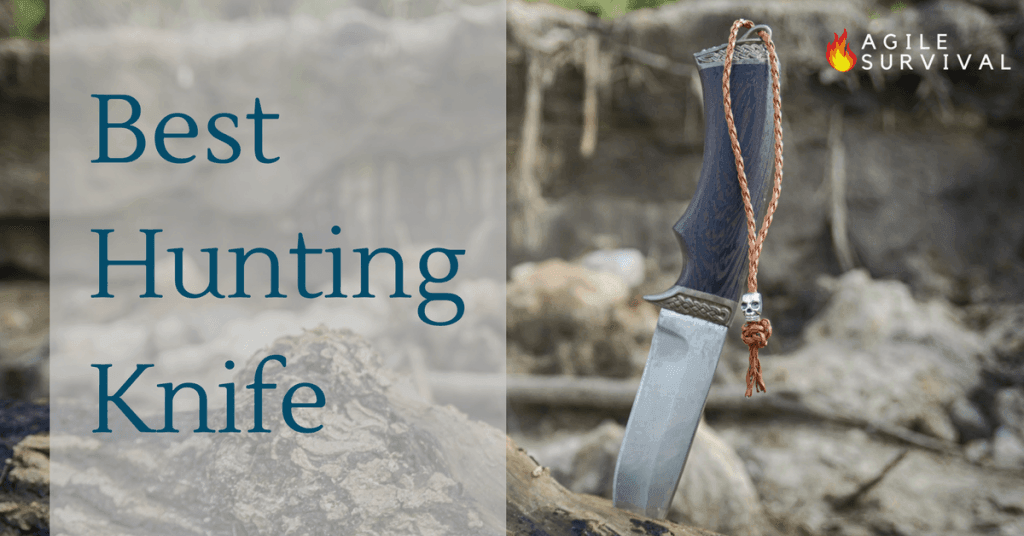A hunting knife does more than just process meat after a kill. It also comes in handy during survival situations. In this post, we discuss features to look for and review the 5 best hunting knives on the market today.
The Best Hunting Knives 2019
CHOOSING THE BEST HUNTING KNIFE
Every hunter needs a good hunting knife but choosing the right one needs can be tricky. Keep these factors in mind next time you are looking for the perfect hunting knife.
Fixed Blade vs. Folding Knife
Hunting knives are often classified into two categories: fixed blade and folding knives.
Fixed blade knives are usually best for hunting. They can be harder to carry around. But, unlike folding knives, they don't have moving parts. As a result fixed blade knives are more reliable, stronger, affordable and last longer folding knives.
Folding knives are easier to carry and more versatile.
If you opt for a folding knife, don't buy a cheap one. It won't last long.
Pay close attention to the locking mechanism. It must have a strong lock back, grippy handle and thick blade. A folding knife with a partially serrated blade is super useful for cutting through tendons and cartilage.
Blade Length
People tend to overlook blade length at first. They don't realize blade length affects reach and the amount of control they have over the knife. Short knives have a reduced reach but offer way more control than longer ones.
Longer knives are useful for skinning larger game as they offer increased reach. If you need a knife for capping and skinning small game, a 3" blade length is plenty. Professionals who prefer big game, like elk or deer, need longer 5" and 6" blades. So they can work with their hands farther from the carcass.
Blade Shape
There are three main blade shapes to choose from:
The clip point blade has a straight spine with a straight, concave or short drop at the end where it looks like it's being clipped off. It positions the blade below the spine and close to the center, giving the wielder more control. A good example of a knife with a clip blade is the Case Bermuda Green Bone.
The drop point blade is arguably the most popular in hunting. It is similar to the clip point blade. But, instead of a straight or concave curve at the end, it has a convex curve that extends from the spine to the tip. The Benchmade Griptilian 551 is a good example of a knife with a drop point blade. A trailing point blade has a long, concave curve along the spine that places the blade tip above the spine. This reduces control you have over the knife and increases the length of the sweep.
Clip point and drop point blades are good for skinning game like elk, deer and antelope with loosely attached hides. I prefer the trailing point blade for skinning animals with tightly attached hides. It's much easier to carve the skin off the carcass.

Type of Steel
There are two main types of steel used to manufacture most bladed tools like hunting knives and machetes - stainless steel and carbon steel. High carbon steel is also used. It's a hybrid material that combines the best of stainless steel and carbon steel. It is also quite expensive.
While carbon steel hunting knives are more durable, rugged and cheaper, they are susceptible to rusting. Applying a layer of silicon with wax on the blade or keeping it oiled should help reduce the risk of corrosion. Despite being more difficult to sharpen, stainless steel knives are more popular among hunters because they don't need as much maintenance.
Handle
The handle of your hunting knife needs to be comfortable and made from a strong, durable material. It should also provide a firm grip, even in wet conditions.
Avoid any knife with a leather, wood or bone handle. They can be slippery and don't hold up well in wet conditions. A handle made from a synthetic material like polymer, rubbery plastic or nylon is worth your while.
Tang
Your knife must have a full tang design. Do not compromise.
This is where the blade of the knife or machete extends all the way to the end of the handle. Not halfway through. Knives with a partial tang have weak points don't last long. Especially when it comes to tough jobs.
The Best Hunting Knives of 2019 Reviewed
1. Morakniv Companion Fixed Blade Knife
The Morakniv Companion is an all round outdoorsman/bushcraft/survivalist knife that has a lot to offer when it comes to hunting. It has a 4.5" handle and a 4" blade, which sums up to an overall length of 8.5 inches. Its drop point rendition is nearly perfect and we love the balance between the straight and curved edge.
The blade is made using 12C27 high carbon steel, which is a great choice given the price. It holds up well when cutting up the carcass and the edge is very easy to sharpen.
I know what you are thinking... carbon steel rusts! Fear not. Morakniv provides a plastic sheath prevents moisture retention.
The Morakniv Companion comes with a plastic handle that makes the knife lightweight. It has a patterned, high friction grip and gives you plenty of control when skinning your game.
Pros
Cons
2. Buck Knives 119 Special Fixed Blade Knife
The Buck Knives 119 comes with a 6" fixed blade and has an overall length of 10.5 inches. Like other Buck knives, the blade is forged from 420HC steel. This is an older variation of steel that still works great today, holds an edge and is easy to sharpen. The blade is almost 3/16 inches thick, making it a heavy duty knife that will everything from skinning and butchering.
Its handle is made from phenolic, an extra hard plastic that gives the knife a touch of elegance. The ever so slight grooves on the handle make for a firm grip. Hence, better control and more effective handling. Don't ding the butt or guard.They are both made from aluminum.
These days it comes with a nylon sheath, but you can still find the leather sheath that came with the older model. It comes out of package razor sharp and ready sharp.
While the Buck 0119 is not the best for field dressing big game, like elk or deer, it is good for cleaning small game.
Pros
Cons
3. Gerber Ghoststrike Fixed Blade Knife
It may be marketed as a tactical knife, but the Gerber Ghostsrike has plenty of features for hunters. It is a small knife with a blade made from 420HC steel and a black ceramic coating for corrosion resistance. This is a durable material, but doesn't hold an edge well. The blade has a hollow grind and Gerber provides a traditional belt sheath to cover it up.
The Ghoststrike has a full tang, and a skeletonized blade to reduce weight. We love the black rubberized overmold coating used on the handle since it has a diamond texture. It also has jimping along the finger grooves for a firmer grip.
There are small notches on the belly and spine that function as part of a dual detent mechanism. When you insert the knife into the sheath, it locks with a firm click. The detents do a good job of providing resistance so that the knife stays in place and releases quickly when need be.
Pros
Cons
4. Benchmade Griptilian 551 Drop Point Knife
The USA made Benchmade Griptilian 551 is no small knife. It has a 3.45 inch blade and a total length of 8 inches. What's even better is that Benchmade managed to keep the weight down at 3.88 ounces. So it's big and lightweight.
You get all the benefits of stainless steel - corrosion resistance, good edge retention and overall toughness.
Its injection molded, glass filled nylon (GFN) handle is exceptionally strong. The handle connects to the tang with tight screws and the reversible tip up clip is coated. The handle has grooves for a firm hold and added control for field processing your game. The AXIS utilizes two omega-style springs to give the locking bar the inertia needed to engage tang.
Pros
Cons
5. Buck Knives 284 Bantam Folding Knife
The Buck Knives 284 Bantam is another folding knife for hunters looking for a knife that will fit in their pocket. It's razor sharp 2.75" drop point blade made from 420HC steel, and designed to deliver maximum strength.
You can choose between nine colors. It is corrosion resistance and the edge retention is decent.
One thing we loved about this knife is one hand opening, thanks to the stud thumb on the blade. A lockback mechanism locks the blade open. Adding safety and strength when skinning.
The finger swells on the grip provide a firmer, more comfortable hold. Its lightweight and compact design makes it the great EDC carry knife. Perfect if you want to do more than just skinning rabbits.
Pros
Cons
Conclusion: AND THE WINNER IS...
The crown for best hunting knife goes to the Morakniv Companion. It's hands-down the best hunting knife for most hunters.
It has a strong drop point blade with decent edge retention. Patterned grip for maximum control. Plus, it's lightweight and affordable. Who could ask for more?






